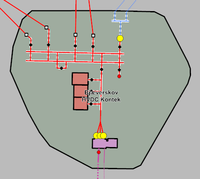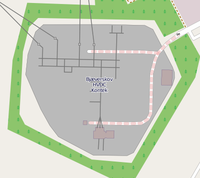Tag:power=substation
| Description |
|---|
| A facility which controls the flow of electricity in a power network with transformers, switchgear or compensators. |
| Rendering in OSM Carto |

|
| Group: power |
| Used on these elements |
| Useful combination |
|
| See also |
| Status: approved |
| Tools for this tag |
|
A substation (601-03-02 and 605-01-01) is a facility for controlling the flow of electricity in a power network. Substations can vary in size from small buildings the size of a garden shed, to much larger outdoor installations of the size of many football fields. They normally contain one or more transformers to increase or decrease the voltage, and are linked to the rest of the network by lines or cables.
Although the majority of substations contain transformers and are used for increasing or decreasing the voltage, some only perform more specialist tasks such as switching or compensation.
This tag should not be used for facilities where power is generated - use power=plant or power=generator instead.
How to map
Tag a ![]() or a
or a ![]() as power=substation. Most substations should be mapped as areas. Very small substations such as small transformer kiosks in residential areas may be mapped as substation nodes, or as transformers.
as power=substation. Most substations should be mapped as areas. Very small substations such as small transformer kiosks in residential areas may be mapped as substation nodes, or as transformers.
In a few cases, a single substation is split over multiple sites (for example on either side of a road), and should be tagged as a multipolygon relation.
The operator, maximum voltage, and a reference code are often marked on a sign outside the substation. These can be recorded in the operator=*, voltage=*, and reference=* tags.
Substation vs transformer
When should a facility be tagged as a substation and when should it be tagged as a transformer? Substations and transformers can be distinguished as follows:
- power=substation represents an area that may contain transformers. It typically also comprises switchgear and other components.
- power=transformer represents a transformer device, as a
 . Power transformers are mostly found inside substations. However, a small distribution transformer located in a power pole is considered by most people to be a "transformer", not a "substation". A pole-mounted transformer should not be tagged as a substation. See power=transformer for more details.
. Power transformers are mostly found inside substations. However, a small distribution transformer located in a power pole is considered by most people to be a "transformer", not a "substation". A pole-mounted transformer should not be tagged as a substation. See power=transformer for more details.
Tagging
The most common tags used for substations are:
| Key | Value | Comment | Recommendation |
|---|---|---|---|
| power | substation | The substation should normally be mapped as an |
Mandatory |
| substation | transmission / distribution / etc. | The role of the substation within the electricity network. | Recommended |
| location | outdoor (default) / indoor / etc. | The physical location of the substation. | Recommended |
| voltage | <voltage>[;<voltage>..] | The voltages of the substation, ordered from highest to lowest (e.g. 400000;225000;63000). It is recommended to tag at least the highest voltage of the substation. | Recommended |
| gas_insulated | yes | Whether this substation uses pressurized gas as insulator. Gas insulation is increasingly used in modern high voltage substations. | Optional |
| name | <name> | The name by which the substation is known. | Recommended |
| operator | <operator> | Name of the company that operates the substation. | Optional |
| ref | <reference> | Abbreviation / reference number of the substation. | Optional |
The location=* tag may also be used together with power=transformer and other components of a substation when their location differs from that of the substation.
location=kiosk has been used to tag compact distribution substation located in small enclosures where technicians cannot enter to work. man_made=street_cabinet + utility=power is more suitable for such objects.
Substation components
It's possible to map the components within substations, especially for larger outdoor facilities. A typical substation comprises at least the following components:
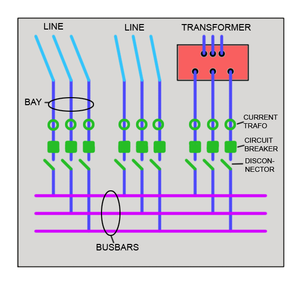
|
Gray: Substation Cyan: Power line Blue: Bay Green: Switches etc Purple: Busbar assembly Red: Transformer |
Power lines: busbars & bays
Power lines within a substation are further categorised into line=busbars and line=bays, with the busbar being the central, high-current connection point of the substation.
There is normally one set of busbars per voltage level, with the higher-voltage busbar being the largest and most visible due to the larger conductor spacing. Bays are lines which run off the busbar to connect to transformers or power lines, usually via a combination of circuit breakers, disconnectors, and instrument transformers.
Lines in substations are almost always in groups of three, with one conductor per phase. These can be tagged as a single way (power=line, cables=3), or individually.
Other components
Examples
| Maperitive | OSM Carto | Tagging | Note |
|---|---|---|---|
| landuse=industrial utility=power power=substation substation=converter name=Bjæverskov HVDC Kontek voltage=400000;132000 (valve hall) building=industrial power=converter name=HVDC Kontek operator=Energinet.dk poles=monopole rating=600 MW voltage=400000 |
Bjæverskov HVDC substation in Denmark (northern terminal of Kontek HVDC connection). Bing imagery of the substation. |
| Photo | Tagging | OSM Carto | Note |
|---|---|---|---|
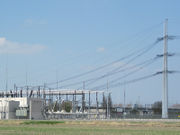
|
barrier=fence utility=power power=substation voltage=380000;150000 substation=transmission name=380kV Bleiswijk operator=TenneT |
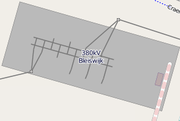
|
380 kV substation with three 380/150 kV transformers. Unusual for using outdoor gas insulated switchgear (GIS). |
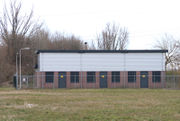
|
On surrounding perimeter: barrier=fence utility=power power=substation voltage=25000;10000 substation=distribution location=indoor |
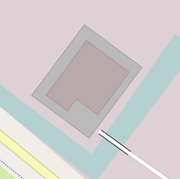
|
Indoor 25/10kV substation near The Hague. The entire fenced area should be mapped as a substation, not just the building. |
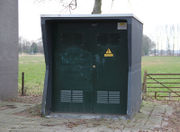
|
utility=power power=substation voltage=10000;400 substation=minor_distribution operator=Stedin |
An example of a small kiosk type substation. | |
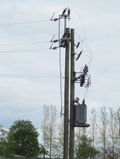 |
location:transition=yes transformer=distribution voltage:primary=10000 voltage:secondary=400 |
Typical pole mounted 10 kV transformer. | |
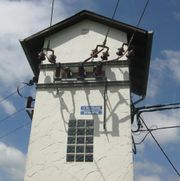
|
utility=power power=substation voltage=10000;400 substation=minor_distribution |
Characteristic tower type transformer building functioning as an electricity pole. | |
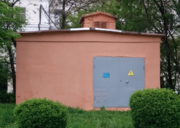
|
utility=power power=substation substation=minor_distribution voltage=10000;400 |
Typical minor distribution station located in a small masonry building. |
Tools using this scheme
- Maperitive power rule set for rendering the substation features of this scheme in Maperitive.
Possible tagging mistakes
See also
- power=generator - A device which converts one form of energy to another, for example, an electrical generator.
- power=plant - An industrial facility where power (electricity, useful heat, biogas) is produced by individual power generator units.
- Proposed features/Substation refinement: The approved substation proposal.
- Portugal/Energia/Subestações - list of power substations in Portugal

